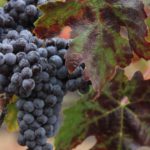Wine – Change is in the Air?
Why doesn’t a particular wine, from the same varietal, grown in the same vineyard, produced by the same vintner, taste consistently the same year after year? Your favorite Cabernet Sauvignon, Chardonnay or Pinot Noir from 1999 to 2001 or 2015 to 2016. Any number of factors could challenge this question but without a doubt, climate and human intervention are likely to be the usual suspects.
Let us first examine the vineyard, where the birth of the grape occurs. Most often, it’s the various types of climate indicators that challenge their development. Wind, rain, frost and sunshine are but a few of the many elements that determine a grapes fate in the vineyard.
Spring rains prior to flowering and bud break are essential in jump starting the birth of a grape. Yet, rain and often times hail can harm, impede or even destroy the newly forming buds on a vine in its early stages. Excessive rainfall during the growing season may result in plump fat grapes, excessive clusters and an overall decrease in flavor profile. Rain during harvest is nothing short of a disaster waiting to happen. This occurrence is a vintners worst nightmare, often resulting in weak flavors, less concentrated juice and a thinner crop.
Frost may impede a grapes potential either early or late in its development. In Spring, a frost could kill a buds chance to flower, resulting in a weaker or limited crop come harvest. An Autumn frost may hamper the grapes potential to fully ripen, exhibiting tart flavors, irregular balance, with possible damaged or even dead clusters.
Sunshine is any plants best friend. The more, the better. Too many cloudy days and lack of sun during growing season will often effect the final outcome in a grapes flavor profile. Overall temperature swings in daily degrees, both during the daytime and at night, have a profound effect on balance in the vineyard. All these components, including wind, variables in the types of soil within a vineyard, vineyard pests, imparting chemicals, organic practices, plus all the unexpected nuances Mother Nature can surprise us with, all play an intricate role in the life and quality of any grapevine.
Once natures role in the vineyard is complete, we now move to the winery itself, where it is now left to the skills and talents of the winemaker to transform what the vine has given him to work with. Factors now include….
1) The method in which the grapes are harvested, either by hand or by machine. Also, whether it is decided to harvest during the day or during the night.
2) Once harvested and at the winery, the chosen process on which the grapes are selected, electing or not to destem, to crush as whole clusters or as individual grapes, all of which are important options a winemaker determines.
3) His style and length of fermentation, to do so in barrel or steel tanks, the various type, size and selection of wood used by the cooperage in making the barrels, all of which have various impacts of the final product.
4) To blend, to manipulate, to separate select grapes to use in reserve or single vineyard wines, cork, screw cap or alternative closures, the labels, all this and more determine what the vintner will eventually transfer into his final bottling.
After month’s or even years long process, it is now time for the winery to release their products to the public. As a consumer, it is now left up to us to render judgment as to the wines ultimate status. We taste, we analyze, we rate it, we give it thumbs up or thumbs down. It is at this point where knowledge becomes key to your tasting success. Does your 2014 taste the same as your 2013? Do you still enjoy your favorite wine or does it seem slightly different?
Which brings us back to our original question on how a wine tastes, either similar or quite contrasting, from vintage to vintage. We looked at the scenarios that occur in the vineyard and in the winery, now let’s examine the role it plays once purchased and in your home.
Everyone has their favorite wines they often gravitate to when making their selections, be it by varietal, by its producer, by country of origin or by suggestion from your local wine expert. One mistake often made is that you may not take the time or effort to fully examine the wordage on the label. Remember, this change occurs each and every year. This may lead to an incorrect purchase, resulting in a wine that may taste dissimilar, unpleasant or unfamiliar from what you may be accustomed to. This error in judgment may occur due to change in vintage date. You may have grabbed a 2017 instead of a 2016 which was your choice in past purchases. The difference in taste could also be a result of the winemakers change in blending or the purchase of grapes from a different vineyard source. It could also be determined by a change in winemaker at the winery. New winemaker, new style, new taste.
Over the years, I have hosted many vertical tastings of certain wines. That being, the same wine, same producer, different vintage year. In each bottle, subtle differences are very noticeable. Flavor characteristics vary from vintage to vintage, fruit nuances change, tannin structures may be larger or weaker, one bottle may show floralness, the other degrees of smoke, more acidity, more pepper, less oak. All variances determined by change.
The final key factor may lay in what we discussed earlier, the climate in the vineyard and/or the creativity in the winery. Weather is never the same or consistent day by day in any given year. Too hot, too cold, lack of rain, too much rain, sunny one day, cloudy the next. Take for instance a natural disaster, the wild fires on America’s West Coast. Smoke from those blazes often times impart certain flavor profiles to a wine. They have also been known to ruin an entire crop, or much worse, destroy the vineyard itself. Change in the weather, change in the wine.
The weather geek in me watches these changing patterns worldwide every growing season. It helps in predicting how a crop may be effected, thus pre-analyzing what challenges a winemaker faces in creating a quality product. In the end, it assists me in educating the wine drinking public as to the success or failure may occur in an upcoming vintage.
A bottle of Cabernet from California, Washington, France or Chile will all taste different with various flavor nuances and profiles. Same varietal, different country, different winemaker, different taste. Pinot Noir from the Burgundy region of France will taste quite different from those from the Willamette Valley of Oregon or those from the Central Coast of California. Chardonnay from Australia, Riesling from Germany, Sauvignon Blanc from New Zealand, Merlot from South Africa, all will taste substantially different from its same counterparts from around the globe. When it comes to the difference in taste, your praise or dislike of any wine, can all be determined by 2 main factors: Weather and Winemaking.



